










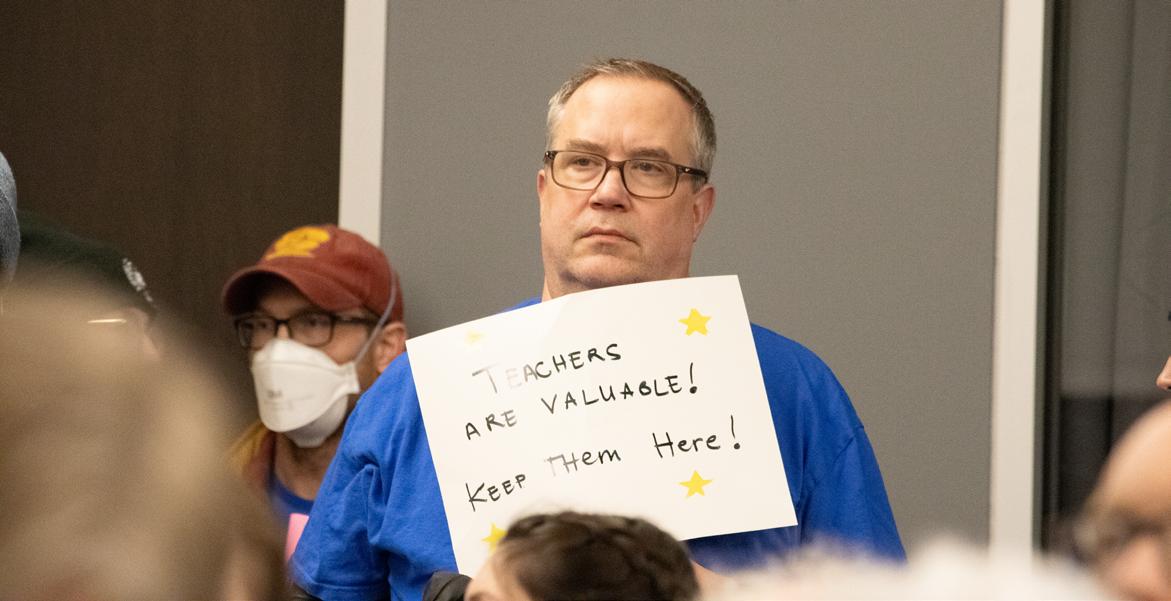
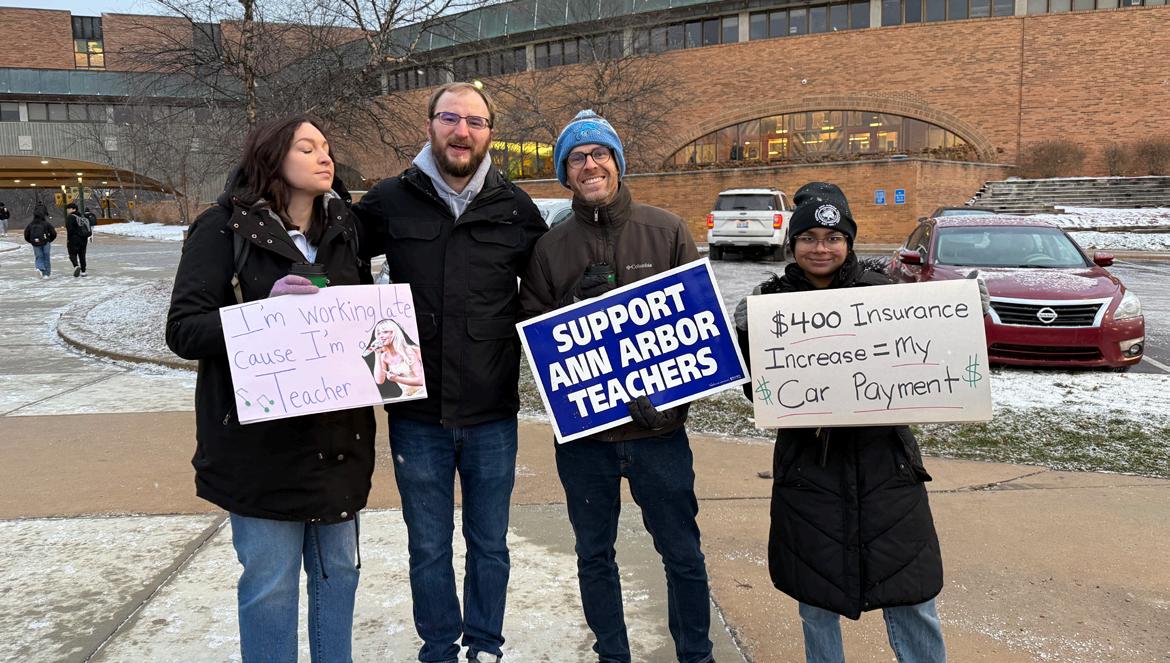
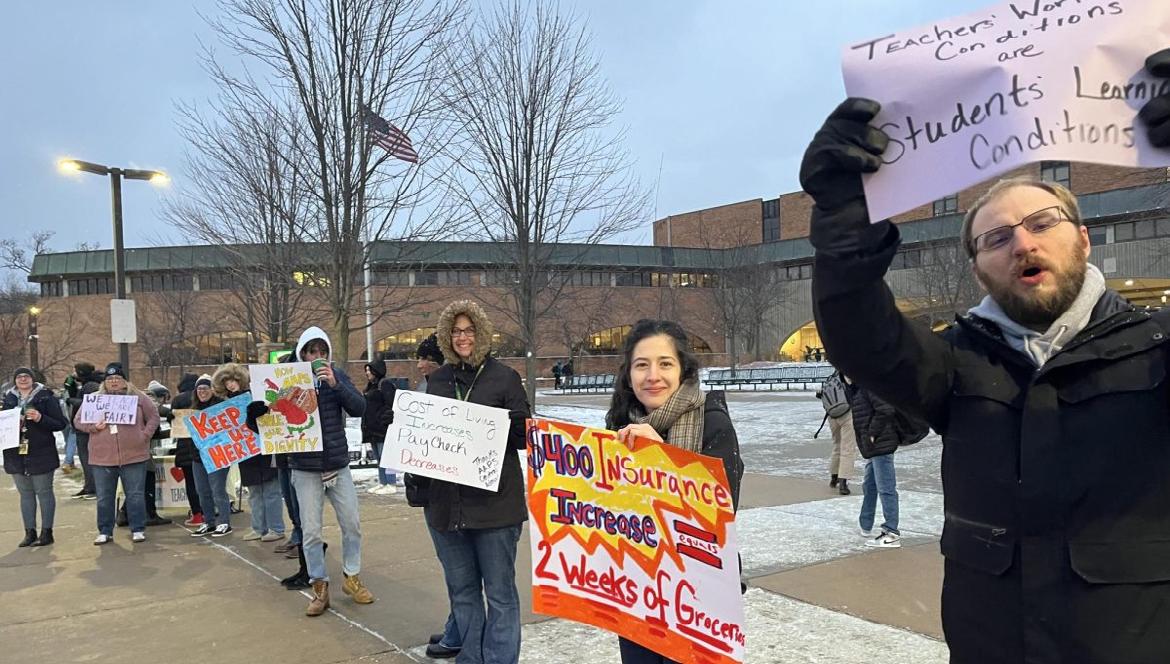

SATVIKA
RAMANATHAN
EDITOR-IN-CHIEF
When Huron English teacher Daniel Crowley was asked as a kid what he wanted to be when he grew up, he responded that he wanted to scoop ice cream.
“Don’t you want to own the ice cream shop?” his dad responded.
“No, that’s way too much of a headache,” 8-yearold Crowley responded. “I just want to scoop ice cream. That sounds fun.”
That desire to love his career stuck with him. But instead of ice cream, he found a passion for education. And

he has fun. But in the last year, he’s been faced with the reality that he might not be able to afford to do what he loves long term. At the beginning of the new calendar year, healthcare prices shot up for teachers.
The district funding is tied to a bill called PA 152 that stated that the district would only pay 0.2% more of the healthcare cost this year. According to Ann Arbor Education Association (the AAPS Teacher’s Union) President Fred Klein, that amounted to about an additional $30 for the whole year. However, the cost of the healthcare premiums themselves increased

drastically this year. Some plans were double the cost.
“The amount of money that we’re making isn’t changing, so it’s essentially what equates to a pay cut,”
AAEA Action Team Chair and Huron teacher Sarah Anton said. This has been especially difficult for teachers, given the financial situation the district has been dealing with following the $20.4 million budget cut made by the AAPS School Board last year.



“All teachers are really upset,” Klein said. “The people in the district that are making the most money are paying


MAYA FU
&
JULES HESKIA PRINT EDITOR IN CHIEF & GRAPHIC EDITOR
“Kent D. Overbey Track,” the green and blue plaque on the edge of Riverbank Stadium’s track reads. “Teacher. Mentor. Coach.” Having served as Huron’s Boys Cross Country coach for over four decades, Kent Overbey’s roots at Huron High School run far and wide, spanning from the Humanities department to the athletic wing. His recent announcement of retirement marks the departure of an integral part of Huron’s history: he is the last remaining person at Huron who was part of the school’s first staff after its creation in the fall of 1969.
“Like all kids, I wanted to be an athlete and thought my success would be in basketball and football,” Overbey said. “But I became aware that perhaps my limited talents might lend themselves more to track and distance running.”
He joined Kirkwood High School’s track team in ninth grade soon after, but also continued playing basketball until 11th grade, and football through 12th grade. His football team won the Missouri state championship in the fall of 1955, but by then, Overbey had realized where his true passion lay.
“most males, I had no idea what I wanted to do for a career,” Overbey said. “But I kept getting bugged by my counselor, so I thought that maybe I’d like to be like my high school coach.”
He coached many people over the years at Huron, but he never forgets any of them and has all of the records going back to when he started.”
LUCAS WEINTRAUB CROSS COUNTRY RUNNER
“I played [on the football team] but wasn’t a star,” he said. “I would never exchange those memories; I have no regrets, but making All-State in the mile and 800 meter five different times told me what to focus on.”
It was his high school coach, Coach Emil Wiggins, that inspired Overbey’s 65 year coaching career.
“In high school, like

AMELIA BAI COPY EDITOR
Five years ago in March of 2020, the Huron Symphony Orchestra played the 1812 Overture by Pyotr Ilyich Tchaikovsky in Hill Auditorium during Orchestra Night, an annual AAPS orchestra performance. This would be the Huron Orchestra’s last performance before the worldwide pandemic
Both his first teaching and coaching experiences were at Kirkwood High School, the high school he graduated from in 1961. Simultaneously serving as a social studies teacher, under his leadership, his cross country team placed 2nd at the state meet, and placed 1st the following year. In 1964, he left teaching and coaching to join the Peace Corps in Iran for approximately two years. Upon returning home, he began to substitute teach while pursuing an MA in Education at Washington University. Subsequently, while pursuing an MA in History at the University of Michigan, he served as a teacher assistant and assistant track coach at Ann Arbor St. Thomas. Eventually, while running the after school sports program at St. Francis of Assisi Catholic School, he learned about the opening of a new high school –Huron High School. The fall of 1969, in which he began teaching
Humanities and serving as the head track coach, marked the start of Overbey’s decadeslong journey at Huron.
“My high school running seasons with Kent are some of the best that I will ever know,” said Lucas Weintraub, a former Huron cross country captain and a current freshman at Northern Michigan University.
Weintraub ran competitively from sixth

grade through senior year of high school. One of the things that Overbey is known for most are his “Kentisms”: quotes or sayings that he would repeat to his runners. Overbey wanted not only to be a positive role model for his athletes, but wanted them to be role models for their school, their team, and themselves. These brief, no-nonsense snippets of advice were a way for Overbey to guide his team both on the track, and in life.
“He was the first person I called when contemplating the idea of whether or not I should graduate early,” Max Samaha, a senior on the cross country team said. “He said, ‘Why? Why do you want to do it?’ And he told me one thing that really stood out. He said that everything you do should have rationale and thought behind it. And moving forward, from that, I’ve learned that you really need to weigh things, weigh out the pros and cons of things, and think things through before you make a decision.”
According to Overbey, running – but also life in general – has no shortcuts, and success will be the result of nothing but hard work. “We wanted to always be sure
COVID-19 hit, sending the entire world into lockdown. The then seventh graders sitting in the audience during the 1812 performance are now seniors; the piece was performed at the Michigan Music Conference (MMC) on Jan. 24, joined by members of the Huron Symphony Band and the Huron A Cappella and Bel Canto choirs. Students thoroughly enjoyed the trip, as well as the performance. For many seniors, the performance felt
akin to a full circle moment.
“When I first heard the performance in seventh, I was one of the people to give a standing ovation,” senior and violist Katherine Ma said. “It just blew my mind away. I’ve always asked Mr. Krohn, ‘Can we play this?’ And he was like, ‘Yeah, we finally can.’ So I was really happy. Just being able to play what I heard [in seventh grade] is such a different experience.”
that we outworking all the other teams. All the hard work does not guarantee success, but it does guarantee the chance to achieve success.”
Not only did Overbey work tirelessly to instill this drive in his athletes, he utilized it himself in his own work, devoting himself entirely to coaching.
“The workouts he gave us were hard but they helped because there was real math behind them,” Weintraub said. “While we learned in class everyday, he’d be in his office or at home calculating our pace times for the next workout we were going to do. You can’t just give workouts and call yourself a running coach; Kent put in the hard work and that’s why he is a good coach.”
His role in not only the Huron community, but the entire Ann Arbor community, is evidently irreplaceable.
“Anytime we go out for a run across the city and be with Kent, someone would reach out to him and recognize him,” said Samaha. “And it was always for the most positive things, too. It was for some impact or meaningful connection that he established with someone. His willingness and dedication to a career of
service is extremely notable. ” His dedication to everybody he interacted with manifested in countless ways, from the 20 mile drive he had to make from his house to Huron each day, to hurrying around race courses to cheer on his team, to caring for and remembering each and every single one of his athletes.
“He coached many people over the years at Huron, but he never forgets any of them and has all of the records going back to when he started,” Weintraub said.
Overbey’s memories of unforgettable moments in his coaching career reflect this sentiment.
“There are far too many to recount, but some come to mind,” he said.
The first state championship team at Kirkwood. They not only went on to great success in college and their careers, but also served their country in tough times, and were awarded many citations for bravery under fire.
The 2003 team of Tinney Daoud, Lisull, Riker, Hamilton, Rudy, and Gao,

SHAYLA LY AND ELLISE BAIDEL GUEST WRITERS
“The perfect recipe for a disaster,” is how Haley Kluge described the scene right before the catastrophic fires began in the Palisades in Los Angeles. “The winds, the dry conditions, we haven’t had rain in months. It feels like historic winds. This was a perfect storm.”
Standing in the middle of her beautiful home in Santa Monica, California, Kluge watched and waited as the intense winds pushed the orange glow of the fire closer to her home. In 20 days, 57,174 acres and 16,240 buildings burned due to the Palisades fires and exaggerated by the conditions. Spreading quicker than they could be contained, California officials work relentlessly to protect and preserve neighborhoods before the fire can reach them first. Keeping one eye out the window and one eye on the news for days on end, Kluge waited for her county to be listed as an official evacuation order, which it quickly was. During natural disasters, California has a three-stage evacuation policy to communicate to residents their safety status. The first stage is READY, which is a red flag warning, meaning that there is an increased risk of
fire danger caused by warm and dry conditions as well as strong winds. The second stage is SET, which is an evacuation warning, meaning that there is a high potential for an evacuation order and people should begin preparations. The third and final stage is GO, mandatory evacuation, meaning that your life is in danger and it is required for you to leave your current location.
Residing directly in the path of the fire, Kluge went from being in the READY stage on Tuesday to being in the GO stage on Wednesday, making it mandatory for her to evacuate, and giving her little time to get out. Luckily, Kluge was able to quickly adapt to the situation to maintain her safety despite the 24-hour notice.

“Once I was in the READY evacuation warning stage, I packed my bags to be ready to run and go,” said Kluge. Leaving her home and the life she created in the hands of fate was not an easy task. Kluge speaks highly of her network of support that ranges from her Midwest hometown to the newer connections she has created for herself in California.
“I had so many friends reach out and offer their homes for me and my partner to stay at if needed,” said Kluge, “I felt very grateful to have that support system around.”

Emotional support, particularly during trying times, plays a crucial role in a person’s well being as demonstrated by Kluge’s first-hand experience within the Palisades fire, as well as the upcoming story of Linda Corlew, a Special Education teacher at Huron, who recounts her experience of having a family member in California during this tragic event.
Linda Corlew’s sister, Lisa Michelle lives in West Hollywood with her husband, Julian, and two cats, Trinity and Georgie. Uncertainty is a major stressor for family members during devastating natural disasters such as the Palisades fires, however, Lisa’s frequent updates have been able to prevent that for Corlew.
“I was a little freaked out at first but she is good about communicating in the family chat,” said Corlew. Unlike Kluge, Michelle is not in an evacuation zone meaning she has been able to stay safely in her home and continue with her work. However, life has looked very different for Michelle and her husband during the fires.
The majority of their jobs have transitioned into service work in their community to support those who have been affected by the fires, helping as much as they can to restore California to what it was.
“This type of work has taken over her daily,” said Corlew, speaking on behalf of her sister and how her contributions toward her community
affect her everyday routines. Despite the work many, including Michelle and her husband, have put into the community and the endless support surrounding the victims, the fires in and around the Palisades have persisted. The fires have put countless citizens in dire danger and led to 28 confirmed fatalities so far. As officials work to contain the flames, the fires continue to spread at an alarming rate. But as of today, the Palisades fire is at a 90% containment rate after burning for the past 20 days. Each day brings more promise of a fully restored California, complete with the sense of community that brings thousands together.
ISHA SAVI COPY EDITOR/ZINE MANAGER
On Jan. 19, Qatar and the United States announced a ceasefire deal between Israel and Palestine after over 460 days of conflict. According to Al Jazeera, the ceasefire will happen over the course of three phases, each lasting at least 42 days. The first phase handles humanitarian aid, focusing on the exchange of hostages and the withdrawal of the IOF (Israeli Occupation Forces). During the first phase,
Hamas released 18 captives and Israel released hundreds of jailed Palestinians. While the ceasefire offers a temporary peace, the potential for renewed conflict remains if Palestine is unable to decide how they are governed within the 42-day timeline. The next two phases were discussed on Feb. 4th with President Trump in Qatar. Few details have been released to the public, though Trump said he [has] no guarantees that the peace is going to hold,” to reporters on the day,

according to NEWS10 ABC.
Since January of last year, the call for a ceasefire has made waves in AAPS when the district passed a resolution calling for a bilateral ceasefire, drafted by board member Ernesto Querijero. The resolution was polarizing according to the Associated Press, with some stating that its passing would open the topic to further discussion and others stating it would isolate students and was performative at best. Little action has been taken by the board since, though student action has been profound. Skyline senior Salem Campbell has been active in Palestinian activism since the conflict was brought to light last year. Most notably, he has organized a walkout in support of the cause this fall.
“I think any kind of support for Palestine is helpful for the overall movement and even if it’s little,” said Campbell. “Any fundraising or protests can help Palestine get the help they need.” As well as this, many students have shown their support through mediums such Instagram to share posts
related to the conflict. Student activists may face increased scrutiny under recent policies and executive orders.
In a Jan. 30 White House fact sheet, President Donald Trump is quoted as saying “To all the resident aliens who joined in the projihadist protests, we put you on notice: come 2025, we will find you, and we will deport you.” This statement raises concerns about the safety of international students who participated in protests, particularly in light of a related executive order. As well as this, Trump has taken a decidedly proIsrael stance throughout his political career; in December of 2021 he unveiled the ‘Peace and Prosperity Plan,’ a two-state solution that was criticized for having too many requirements for Palestinians. While no official policies have been drafted for his upcoming term, President Donald Trump made a statement regarding Gaza on Jan. 25 saying “I’d like Egypt to take people, and I’d like Jordan to take people. You’re talking about probably
a million and a half people, we just clean out that whole thing.” Soon after at a press conference on Feb. 4, he announced that he wants the US to take over the Gaza Strip.
“We’ll own it ... We have an opportunity to do something that could be phenomenal...the Riviera of the Middle East,” he said, according to NPR. He proposed relocating Gaza’s population to neighboring Middle Eastern countries, describing it as a humanitarian effort. The UN criticized the suggestion, calling it unlawful under international law. Despite these plans being made, no course of action has been created to execute them. The situation remains complex and uncertain, with proposed solutions stirring controversy on a large scale. As student activism continues to thrive and policies take shape, the coming months will be crucial in determining how the ceasefire unravels and whether peace can take hold in the region.
ANJALI NADARAJAH CHIEF CONTENT EDITOR
Left handed people live in a world where everything, from scissors to sewing machines and even cell phone apps, is designed for someone else. These are just some activities lefties struggle with in their day-today lives, and for students and teachers at Huron High School, they are no exception to the life long battle; being an impostor in a world catered to right handed people.
Anna Kauffman, a new teacher at Huron this year, teaches English 9. Her biggest hardship with her unique dominant hand is one many teachers don’t think twice about; writing on the white board.
“I have to hold my arm awkwardly so I don’t erase the board as I write, and it really doesn’t help because I end up with dry erase marker all over my left hand anyway,” she said. “When I write on a piece of paper, I can angle the paper so I don’t smear my writing, but I can’t
exactly angle a white board that is anchored to the wall.”
And as a current teacher at Forsythe Middle School as well, Kauffman grapples with the use of scissors. To her, it’s the most frustrating thing about being left-handed in a right-handed world, causing her papers to be uneven. Like the teacher, junior Jennifer Tang agrees.
“A ton of tools aren’t built for you,” Tang said.
“Growing up, I never had scissors that were comfortable to hold. I guess it taught me to expect challenges and learn how to adapt.”
Kauffman was also forced to accommodate to a world not made for her, challenged daily by things righthanded people didn’t have.
“When I played little league baseball, I didn’t have a lefthanded glove at first,” she said. “My brothers were both right-handed so I had to use their hand-me-down gloves.”
Unfortunately, she is not ambidextrous. In fact, a study by the National Library of Medicine states only approximately 10 percent of
DANIELLE LEE STAFF WRITER
Martial law – a measure intended for national emergencies – has become a breaking point of controversy and resistance in South Korea. Protests have broken out domestically and internationally, including at the University of Michigan’s Diag, where members of the Korean diaspora in local Ann Arbor had gathered on Dec. 8 to speak out what they view as a clear abuse of power by President Yoon SukYeol, South Korea’s current President. This protest, and many others, are a rallying cry for Democracy, reflecting the country’s long history of fighting for freedom and justice.
Martial Law refers to the temporary enforcement of military control over civilians, often used in times of crisis within the nation. Typically, it involves many suspensions to civil liberties, such as freedom of assembly and press, while giving great power to the military. Although this law can be useful for national

people are left handed, and an even smaller minority of 1% are ambidextrous. Kauffman had to make adjustments in her training and practices.
“It made me a better player because I had to sharpen my game instincts to adapt,” she said. “A similar thing happened when I was learning to play guitar. My dad is right-handed and I only had access to his guitar to practice on, so I played it upside down. It definitely impacted how I developed my skills early on.”
Although she eventually got a left-handed guitar and played it that way for 25 years, she thinks the early struggle ending up her in the long run. Tang is a left handed golfer, and is a captain on the Huron girls team.
But unlike Kauffman, she plays her sport right handed. “I found it more convenient to find gear just starting out,” Tang said. “However, I do wonder what my game would be like if I catered to my dominant hand. [While] my main swing isn’t affected much, my coach and I have theorized that my putting

emergencies, it has historically been misused to suppress voices and centralize power, namely one event that all South Koreans remember:
The Gwangju Uprising of 1980. What started as a student-led protest against the extension of martial law by the military leader Chun Doo-Hwan, quickly grew into a broader movement for democracy. But despite the growing support, it was met with brutal suppression, killing hundreds of civilians and injuring countless others, cementing Gwangju as a tragic moment of South Korea’s democratization.
Fast forward to today, President Yoon Suk-Yeol’s recent declaration of martial law has ignited widespread criticism.
Protesters have argued that this move is less of addressing a genuine emergency and more about gaining power. Sangheon Song, a principal engineer at Tenneco who had participated in the Michigan Diag protest, shared his perspective:

stroke is curved due to a leading left hand instead of right, which is one of the reasons I struggle with putting.”
Despite the challenges they face, people like Kauffman and Tang managed to find ways to adapt throughout their life, turning their obstacles into strengths.
EDITORIAL BOARD:
Maya Fu 314166@aaps.k12.mi.us
Satvika Ramanathan 405293@aaps.k12. mi.us
Ashley Kim 316519@aaps.k12.mi.us
Anjali Nadarajah 424587@aaps.k12.mi.us
ADVISER
Sara-Beth Badalamente
Emily Hu, Ishaan Kamat, Kasia Phan Website
Editors-in-Chief
Julya Mae Jones & Kiki Choi Social Media
Editors-in-Chief
Rowan Grenier Sports Editor
Anna Lee Art and Design Editor
Jules Heskia Graphic Editor
Hemanth Tavane Shivakumar Broadcast Editor
Isha Savi Zine Editor, Copy Editor
Amelia Bai Copy Editor
Nadia Ochoa Peterson News Editor Ella Yip Feature Editor Grace Henley Arts and Entertainment Editor Yuanchen Zhao Design Editor Sydney Aldrich Staff Writer Adyien Alston Staff Writer Ryan Bezas Staff Writer Jamison Black Bear Staff Writer Nyzire Brown Staff Writer
ISHAAN KAMAT, KASIA
PHAN AND MAKO IRIE
WEB EDITORS IN CHIEF AND STAFF WRITER
The Michigan Immigrant Rights Center (MIRC) has long been a crucial advocate for undocumented immigrants seeking access to legal representation and various services. One of their primary focuses is assisting unaccompanied minors— children who arrive in the U.S. without a parent or guardian.
“Most of our attorneys work on cases involving unaccompanied minors, helping them find legal relief like Special Immigrant Juvenile status, asylum, U visas, and T visas,” Susana Hernandez, a MIRC staff attorney shared. This work is vital, as these children often have limited resources and face significant challenges in navigating the complex immigration system.
While undocumented immigrants have the right to seek legal counsel, there are significant barriers to accessing that support. Unlike criminal cases, where a court may appoint an attorney, immigration cases do not guarantee legal representation.
“You have the right to seek an attorney, but there’s no requirement for the court to appoint one,” Hernandez explained.
Despite these challenges, MIRC offers valuable resources for those seeking assistance. This has become especially important as the organization also advocates for legislative changes, such as the Drive Safe bill, which aims to grant undocumented immigrants the ability to obtain driver’s licenses.
One of the biggest challenges for immigrants in Michigan is finding a legal path to permanent residency. For many, securing asylum can be a long and difficult process.

“It can take years to receive a decision,” Dan Keener, the supervisor for MIRC’s Data Team, said. “And with the waiting time comes uncertainty, especially for families hoping for a better future.”
In addition to asylum cases, MIRC works on Special Immigrant Juvenile status applications, which are often essential for minors who have faced abuse, neglect, or abandonment.
“It’s a long process, but it’s a necessary one for kids in need of protection,” Keener explained.
A particularly powerful example of MIRC’s work came from a case involving a mother and her threemonth-old child, who were separated by Border Patrol after crossing the U.S. border.
“The mother was promised that her child would be returned to her, but that didn’t happen,” Keener recalled. “We were able to reunite them after much effort, but it was an incredibly complicated case. How do you represent a child who can’t even speak for themselves?”
In response to the challenges of the COVID-19 pandemic,
The Michigan Immigrant Rights Center is dedicated to ensuring the safety and protection of undocumented immigrants in the U.S.
MIRC adapted quickly to continue serving clients. With many hearings moving online, the organization expanded its ability to represent clients from across the state, including remote areas like the Upper Peninsula.
“The shift to digital hearings allowed us to serve many more clients,” Keener noted.
Despite these innovations, the pandemic highlighted the urgent need for better conditions for detained immigrants.
“During the pandemic, we had to make sure that our clients had access to basic health protections like masks and sanitation,” Keener explained.
MIRC also partners with other organizations to amplify its impact.
“We work closely with groups like the Michigan Coalition for Immigrant and Refugee Rights and the ACLU of Michigan,” the representative shared.
Through these partnerships, MIRC is able to advocate for policies that benefit immigrants in Michigan, such as the Drive Safe bill and greater access to driver’s licenses.
As of 2023, about 738K MI residents were foreign-born.
This shows a 1.4% increase from 5.9% in 2010 to 7.3% in 2023.
As Michigan continues to evolve in its approach to immigration, organizations like MIRC are essential in ensuring that undocumented individuals are not left behind. By providing legal support, advocating for policy changes, and working with other immigrant rights organizations, MIRC is helping to create a more equitable and just environment for all.
PHUONG-ANH DO STAFF WRITER
Mark LaLonde has been teaching longer than the students of Huron have been alive. Though a Michigan native, LaLonde began his teaching journey in Washington DC in 2005 where he worked both as a social studies teacher as well as a school administrator and principal. He grew up right outside of Flint in Davidson, Michigan, later attending Eastern Michigan University where he met his wife–whom he’s been married to for over twenty years and has twins with. Washington DC, he notes, is quite a contrast from Ann Arbor. The main difference being the sheer size of the DC district that dwarfs AAPS. There were many opportunities for teachers to collaborate with each other across different buildings, and being in DC also allowed for special opportunities through partnering with the State Department.
“I would have visitors from students from Bangladesh who would come to visit our classroom, or we’d have visitors through
our Model UN program from different embassies to talk to the students.” LaLonde said, “we’d go over to the State Department and do a video conference with kids from Ghana or from Azerbaijan.”
LaLonde also spent some time teaching in Baltimore City, but as his kids got older he and his family decided to move back to Michigan to be closer to other family. It’s been over a decade since he’s taught at a high school, but he’s enjoying the change of pace here at Huron.
“I really enjoyed my teaching experiences previously in high schools,” LaLonde said. “And I’m really glad to be back in this type of environment.”
As a social studies teacher, LaLonde finds a lot to love about the subject; not just in its material content but in how it can be used to further aid students.
“What I really value is making sure that we’re using that [social studies] as a vehicle to teach the skills that students get that can then transcend into other areas of study–future learning and then just success as students continue to grow,” LaLonde said.
Even with the rise and ease of AI, he notes that the ability to communicate and back up your thoughts in a meaningful way will always be an important skill to have, and one he teaches his students. His favorite part of teaching has always been being able to help students in the little ways that set them up for success later in life.
“I love giving students feedback and guiding them and seeing that growth that they make over time,” LaLonde said.
As a teacher, LaLonde says that the best piece of advice students could hear is to make mistakes and reflect on them to promote personal growth.
“We’re in classrooms and students are scared to share something that might not they might not perceive as the right answer.” LaLonde says, “and in life, it’s not about having the right answer. It’s about sharing ideas and growing those ideas and doing those things to make sure we’re growing as individuals.”

JUSTIN PHELPS STAFF WRITER

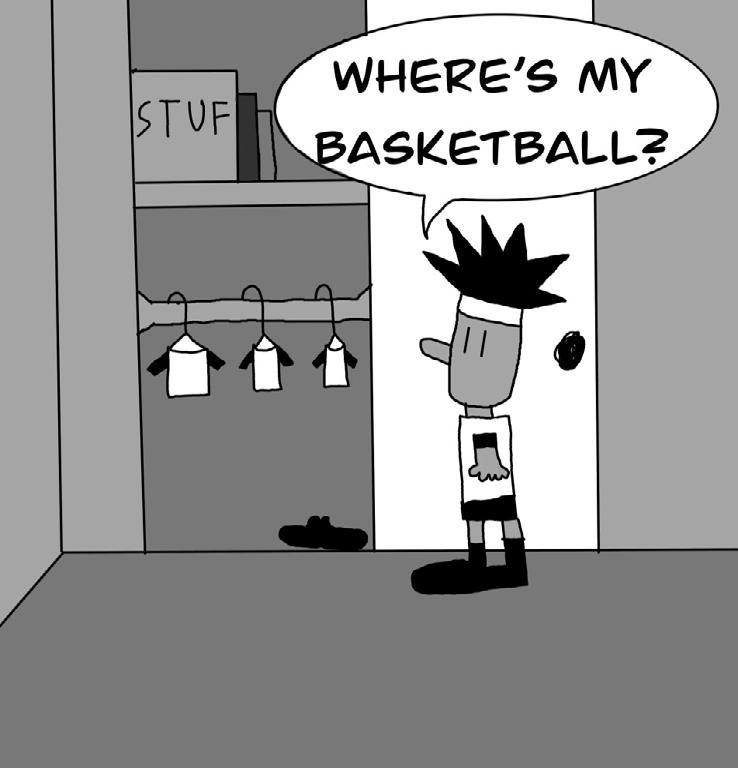




Interested in advertising in The Emery?
The Emery is distributed for free to students at Huron High School and viewable to the public
Scan to fill out our donation form for your tax write off for you or your business.
For more information reach out to the Emery’s adviser, Sara-Beth Badalamente, at badalamentes@aaps.k12.mi.us







My favorite banned book that
Diary
U
is The Absolutely
.

Harry Potter series was banned by my (private) school, along with many other institutions. Reading the books in secret, I realized that the people responsible for the ban actually did not understand them, and I still think that is
of
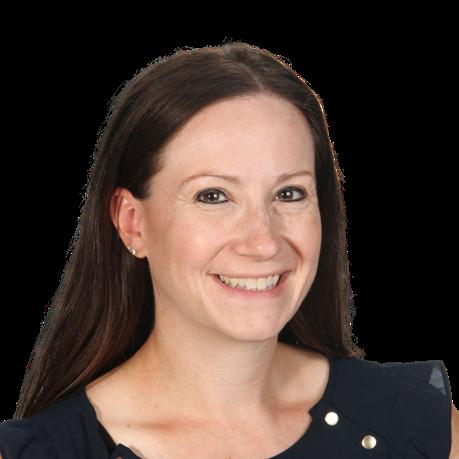
book bans today. My favorite banned book is The Handmaid’s Tale- I read this book for the first time in an honors English course in college called “Law in Literature.” Pairing court cases with this text was a gamechanger in how I thought about narrators in texts.

Well I do have a soft spot for The Absolutely True Diary of a Part-Time Indian because we teach it here at Huron! I also love The Handmaid’s Tale, ever since I read it when I was a senior in high school. I also love The Kite Runner--such a beautifully written book that I genuinely could not put down when I first read it.
ASHLEY KIM MANAGING EDITOR
Located in Briarwood Mall, 24th Cheesecakerie is a local Michigan-made cheesecake company owned by Sean Brezzell. This company has been producing and selling high-end cheesecakes since it got its start in 2015 and currently operates for online, retail, and wholesale customers.
“We just love and have a deep passion for food,” Brezzell said. “Our aim is to provide community and surrendering communities with a sweet, creamy, smooth, delicious, and creative product that will bring our slogan ‘Share a Slice’ to their home.”
Not only does the company focus on the exceptional cakes produced, but it also emphasizes the work and creativity that goes into each and every product. With the company’s motto of “Share your Knowledge,” 24th Cheesecakerie makes sure to recognize the importance
of learning and welcoming diversity and new ideas.
“We intend to change the world by educating others on how to grow their business,” Brezzell asserted. “We are not just a cheesecake company, we are a piece of knowledge.”
The business’s magic is created due to the combination of delicious and unique cheesecake flavors, such as chocolate and raspberry, cinnamon roll, and Superman, as well as their significant core values. These values can be seen in the work environment they create, emphasizing a friendly, family-minded, and hardworking atmosphere.
“Our employees are our number one customers,” Brezzell said. “We take care of them first so they can take care of our guests. Because of them, they are the engine that keeps this machine rolling.”
Although 24th Cheesecakerie is a Blackowned business, they strive for recognition beyond this label through their work, growth, and success.
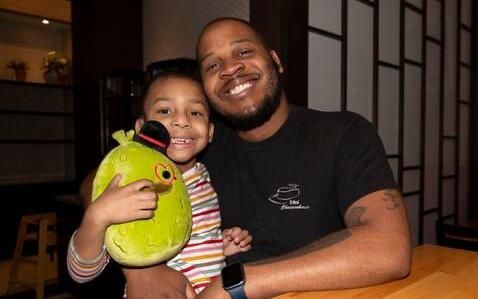
“We don’t put emphasis on being a Black business, we are happy that people love our products and come back for more,” he said. “With us being a three-generation black family business, we have really taken what we have learned over the years to break away
from the black business tag to a business tag. Although we understand the dynamics of being a black business, we know we are more than that and hope to grow so that people can see the success from where we started.”
From MondaySaturday 10 am - 8 pm, 24th Cheesecakerie can be found at 100 Briarwood Cir, Ann Arbor, MI. For more information, visit their website www.24thcheesecakerie. com, or their Instagram page @24thcheesecake.
Uplift & Unify: Exploring Black History through Campus Activism Feb. 12, 5 p.m. Trotter Multicultural Center
Chef Maurice Philpot isn’t just cooking, he’s also adding the needed representation to the local food scene. Wanting to break the mold of traditional restaurants, Philpot strived to create something more
unique, and being passionate about his culture, he opened up a restaurant featuring allblack southern soul food to showcase the representation that was missing in the Ann Arbor area.
Philpot started his career working at a Ford Motor Company plant before deciding to go to Washtenaw

Community College’s culinary school with the hopes of becoming a chef. While in school, he realized that he didn’t want to cook French or Italian food and decided to go the more traditional route and open a chicken and fish restaurant focusing on black southern cuisine.
“When everybody in school was cooking French and different cultures and areas of food, I noticed that most people that are black American were trying to do cooking that wasn’t even from their own culture,” Philpot said. “I decided to be one of the people who kept up a ‘diet tradition’ as I like to say it of southern eating that was not being sought after like French cuisine or Mediterranean or
even Chinese food.”
With this idea in mind, Philpot created his restaurant Mo P’s Chicken and Fish in 2014, hoping to accomplish this goal. While this may seem like a big risk, Philpot and his business have been, and are continuing to thrive.
“Many people grew up on this food: fried chicken, mac and cheese, greens, so I’ve gotten very good reception, especially because there are only two or three restaurants in the county that do what I do,” Philpot said.
“I wanted to be something that was sought after and fun to do and something that I actually liked to do anyway,” Philpot said. “I think it’s very rewarding.”
Mo P’s receives customers from the University of Michigan, Eastern Michigan, Saint Joe’s Hospital, and local high schools such as Huron, causing them to be busy.
Philpot believes that despite there being many local restaurants advertising southern cuisine, not many places offer the real style of food, and instead offer southern-inspired items that are influenced by other cultures, such as hamburgers or chicken. This lack of authenticity to the soul food of the South, and Philpot’s ability to provide the real deal is one of the main reasons that Philpot wanted to start his business.
The True Essence of Black History
Feb. 22, 2 p.m.
Michigan Union Tappan Room
The Arc of Activism with Ta-Nehisi Coates and Angela Davis
Feb. 19, 7 p.m. Rackham
Auditorium, 915 E. Washington St.
The Sounds and Stories of Africa with Fishmonger Stories
Feb. 16, 1 p.m.
AADL Downtown Library
Riverside Arts Center shares Ypsilanti’s Black History
Feb. 15, 4 p.m.
76 N. Huron St.
Black History Month Celebration at U-M
Feb. 13, 11 a.m. Rackham Auditorium
Journey through Africa
Feb. 23, 6 p.m.
Lydia Mendelssohn Theatre
Black Brilliance: Navigating Identity and Professional Excellence
Feb. 25, 2:30 p.m. Atrium, Multiple locations
Soul Train Trivia Feb. 26, 6 p.m.
AADL Downtown Library
Malinda Russell’s Domestic Cook Book
Feb. 27, 5:15 p.m.
AADL Downtown Library
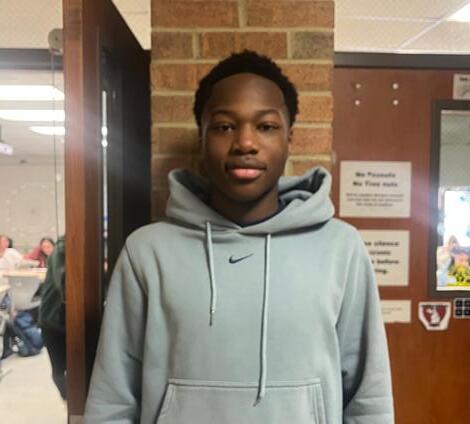


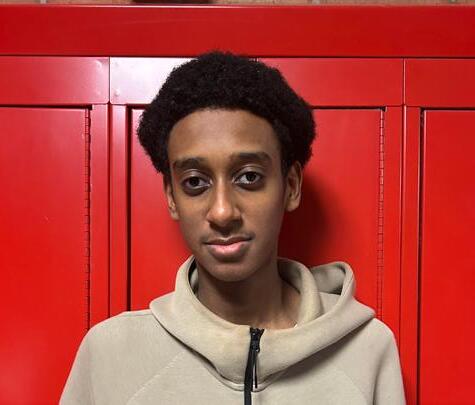
Amadou
What does Black History mean to you?
“To me, Black History is our origins, and how being forcefully removed from our homes led to the prosperity
Lamek Kehase
What can other students learn from the Black History Month?
of Western countries. Black History is American History. Black History is the various groups and activists that took action to fight for their rights and secure them for future generations of African
“Other students can learn about Black History Month by asking people with great background knowledge about it. They can watch a short documentary on YouTube or Netflix to learn what black people went through and how they have made a huge impact in our society, such as people like Reverend Martin Luther
What is the theme of the 2025 Black History Month?
“The theme of Black History Month is Black Excellence. I say black Excellence because, in our society,
What does Black History mean to you?
“What Black History means to me is the struggles and obstacles Black Americans have to face in order to
black people especially have gone through traumatic experiences, such as racial discrimination, segregation, and oppression. But as black people, we have broken those things and become
Americans. Black History is the hardships that our ancestors endured in the past that created traditions and practices that shaped modern black culture.”
King Jr, Malcolm X, and Ruby Bridges. They can watch videos about these wonderful leaders and how they changed history and made an impact throughout the nation.”
such successful people not just only in the United States but even across the world.”
gain freedom in America. Even after slavery Black Americans were still being treated differently and being made fun of. Overall Black History means embracing the challenges and obstacles our ancestors faced remembering those who’ve passed as well.”
Over the past 12 years, Black Stone Bookstore and Cultural Center has been featured on multiple news sites such as CBS News Detroit, MLive, WDIV Local 4 News, Town and Country Magazine, Detroit Metro Times, Hour Detroit, and Elle Magazine.
In addition to that, the bookstore has been visited by famous people such as Vice President Kamala Harris, Actress Octavia Spencer, and Michigan Governor Gretchen Whitmer. One of the owners, Carlos Franklin, is even the first cousin of Huron’s principal Ché Carter.
Carlos Franklin and Kip Johnson started their
business in 2013. They opened this bookstore to make books written by Black authors more accessible.
“We were trying to be different from Barnes and Nobles and Borders,” Franklin said. “We wanted to give people of color a place where they can go and find books that they like from people that look like them.”
Franklin started this business from his love of books and reading. He wanted to share good books that he found with other people but found that just giving books wasn’t enough.
“I [wanted] to find a different way than just giving people books, so I just opened up a bookstore to start selling them,” Franklin said. “It does cater to Black people, but also,
some of my biggest customers are people not of color, so what I think is unique is that everybody can find what they’re looking for here.”
Black Stone Bookstore and Cultural Center has received a lot of encouragement and help from the local community in Ypsilanti.
“I think the local community has supported our business since 2013,” Franklin said. “We made it through the pandemic, so I feel like I get a lot of support from the community.”
More information about Black Stone Bookstore and Cultural Center can be found on their website at blackstonebookstore. com, their Instagram under blackstonebookstore, or their

Facebook page. They are open every day from 11 a.m.-7p.m. except Sunday.
“[The goal is] just to be an encouragement for other people, people that come from our background,” Franklin said. “I’ve never really wanted to open a business and be a ‘Black’ business. I just wanted to be ‘a’ business. When you say a ‘Black’ business, then you paint yourself into a box, that you can only reach a certain level. But when you say ‘a’ business, then the sky’s the limit.”
ESHA JADHAV STAFF WRITER
Many of you might have heard the phrase “honesty is the best policy”, but it makes me wonder, is that really true?
When we were kids, we were always taught to tell the truth, raising pillars of integrity throughout our lives at such a young age. Honesty was always painted as this “golden rule”, a value that separates the good from the bad. But as we grow up, we realize that the world isn’t always black and white. So, can honesty honestly be bad? First off, honesty is the basis and foundation of all relationships: whether friendships, romantic relationships, or family bonds. Without honesty, everything can crumble to pieces. It takes a long time to build a well fortified, trustworthy relationship with someone, and it can take just seconds for it to collapse. Honesty also prevents situations from getting worse. Imagine being in a friendship where you constantly had to question whether the other person was being truthful. It would feel exhausting, wouldn’t it? That’s why honesty matters - it lays the groundwork for
connections that feel safe and authentic. Once you lie, you need double the amount of lies to back up for that lie that may seem so small. If you ask someone how you look, and they ask you “do you want me to be honest or nice?”, I ask myself what does this really mean? Do people give you the honest truth, or just say something for the sake of saying it to be nice? Or is being honest being mean now?
On the other hand, honesty isn’t always as simple as telling the truth. There may be such a thing as being too honest. For example, if
a friend worked for hours making a dish for you, it might not be the best reaction to blurt out “This tastes awful” out loud. In small moments like these, honesty may feel unnecessary. I have experienced this type of honesty in real life myself. I was in a group of four people working on a project for a class. There was one person who wasn’t really contributing much, and they were mostly on their computer doing other off topic things. One of the other group members who was greatly engaged in the project called them out for it in front of everyone, and I

felt it was very inappropriate for them to do so. They were right for criticizing them for not doing the work, but they should have done it privately instead of publicly embarrassing them. Being honest doesn’t mean you should say everything that’s on your mind the second you think of it. Blurting out the truth in a heated moment or when someone’s already upset might make the situation worse. It’s important to think about how and when to be honest. So, is honesty bad? No, not at all. It’s all about balance. Honesty is such a powerful thing, but it also needs to be paired dually with kindness and empathy. At the end of the day, honesty is a good thing - but it’s not always easy. Think about the times when someone’s honesty helped you grow, even if it stung in the moment, or the moments when kindness softened the truth just enough to make it easier to hear. Honesty honestly isn’t bad; it’s just complicated. After all, the way we handle honesty can shape the connections we build and the way people trust us - and that’s something we all can relate to.
In a world that prioritizes celebrating individual achievement, we sometimes overlook the people who built our foundations, whether it be our coaches, teachers, or other mentors.
It isn’t their roles in our successes that make them such key people in our lives – it’s the way they change us as people. Selfdoubt is something that plagues all of us, whether consciously or not. A good teacher is one that has the ability to recognize potential where others may not, and
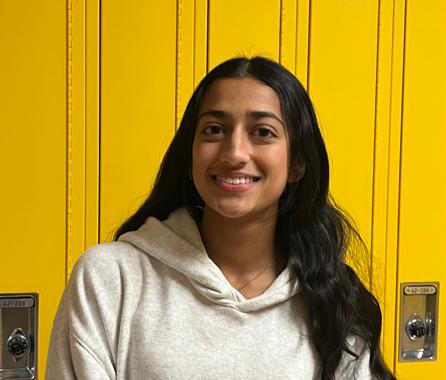

guide us into seeing this potential for ourselves. Only when we understand that we are worth far more than the self-deprecating language we use with ourselves can we thrive, and often, teachers are the ones who reveal this.
“We are going to make errors,” said boy’s cross country coach Kent Overbey. “That is a given, but we always want to err on the side of aggression and not caution because there is no such thing as a mistake. A so-called mistake only proves that someone tried to do something, so no
Who is a mentor in your life?
apologies.”
Having somebody who eternally believes in you, and keeps only your best interest in mind, makes a world of difference. This compassion, in combination with their experience, wisdom, and talent, is what creates lasting impact.
We at the Huron Emery believe that the significance of a good teacher cannot be overstated. From Coach Overbey’s “Kentisms” – dozens of short pieces of advice that his athletes have preserved in a PDF that they pass down year to year – to
“A mentor in my life is my mom. She’s a really great model, she always gives me advice, and she kind of leads by example.
Who is a mentor in your life?
“My dad is my mentor, because he’s always interested in all the same stuff I’m
the way that AAPS teachers have continued to show up for their students despite the obstacles they have faced with health insurance coverage and the recent budget deficit, it is crucial that we are able to recognize that we would not be where we are today without these individuals. Take time to reflect on this fact, express your gratitude, and pass on their wisdom to those less experienced than you. Love, guide, and care for others the way your teachers have for you.
She’s super hard working and kind, even though she likes to work a lot. She always makes sure to spend time with kids with her family.”
Time to change: how Huron would benefit from a block schedule
Right now we rush through our short lunch periods, barely having time to relax, eat, and socialize with friends. HHS should switch back to a block schedule to allow for longer lunch periods and improve our well-being and academic performance. The block schedule would not only allow for longer lunch periods but also more focused class periods that could benefit us in many ways. The main advantage of a block schedule would be the longer class periods. Currently, in the short 50-minute periods, we find ourselves struggling to stay engaged in class, especially for the harder subjects that require us to have meaningful discussions and hands-on work. Longer 90-minute classes not only allow for teachers to delve deeper into their subject but also encourage students in discussions just overall a better learning experience. Overall, it would improve retention and help us feel less rushed therefore improving our overall academic success. Moreover, the longer lunch periods would be an added benefit. We only have 30 minutes for lunch, which makes us feel rushed and stressed. A block schedule would provide an extended lunch period, giving us time to eat if we buy lunch, socialize, and relax. The break in the middle of the day would also help us recharge for the second half of school, which contributes to better focus and mood during later classes.
In addition to academic and social benefits, a block schedule can reduce our stress. With fewer classes per day, we would have more time to manage our assignments, leading to better time management and less overwhelming workloads. The extended class periods would allow teachers to have more flexible teaching methods like group projects or interactive lessons.
interested in so we can talk about it. He’s more knowledgeable than I am.”
All in all, switching to a block schedule would benefit everyone at HHS. It would create a balanced day with deeper learning, better socializing, and reduced stress. Changing to a block schedule is a simple change that has a significant positive impact on us.
SALEM DINH STAFF WRITER
Winter has finally fully set in, and it seems that everyone these days is depressed. It is a harsh statement, but an even harsher reality. The drained look in people’s eyes while walking down the school hallways or driving home from work is contagious, and everyone begins to fall into a cycle of endless melancholy.
Seasonal Affective Disorder (SAD) is a type of depression that occurs specifically around the Winter and Fall seasons. It’s caused by the shorter days and lack of sunlight that people are exposed to each day, manifesting in physical repercussions. Our hormonal balance becomes out of control, and so does our mood.
We become easily irritable and constantly low on energy. We become more sad. I used to struggle with this type of depression, and let it consume my every being each year when the calendar hit September. As the leaves began to wilt around me, I found myself following suit. Dragging myself out of bed became a nearly impossible task, and I lacked any motivation to even exist, much less complete my piles of homework. It doesn’t help that Winter marks the beginning of finals season for Huron, and, overall, the mood drops. Despite the Earth’s fall into an almost lifeless state, I have learned that we don’t
need to follow it. The weather does not need to dictate the way we feel about ourselves or the world around us, and it should not have that effect. We are all capable of enjoying the Winter seasons, and being what is considered “happy” during them.


in finding joy in the small things during the Winter and Fall, and outside of it. I’ve found myself learning guitar during long snow days where I’m stuck in my house with nowhere else to go. Even though it is not necessarily the same as taking a walk outside in the bright Summer sun, and puts a smile on my face.
Finding joy in the small things is what counts to combat not just seasonal depression, but any
or sand between your toes on the beach.
Seasonal depression isn’t incurable, and, sometimes, it only takes the small things to make life better.

ISHAAN KAMAT WEBSITE EDITOR-IN-CHIEF
We’ve all been there— getting a grade that stings. Maybe it’s lower than you hoped, or it doesn’t reflect how hard you worked. It’s frustrating, and it’s easy to let that number or letter weigh you down. The feeling of disappointment can be hard to shake, especially when you’ve put in the effort and felt confident that you’d done your best. It can seem like that single grade is a reflection of your worth, your abilities, or even your future.
But here’s the thing: your grades don’t define who you are.
Think about it. When you meet someone, do you ask what their GPA is? Probably not. Instead, you notice how they make you feel, the things they’re passionate about, or the unique way they see the world. Those are the things that stick with people, not their grades. What makes someone memorable is their character, the energy they bring into a room, and the things they create or share with others. A person’s potential, creativity, kindness, and
vision—those are what truly leave an impression.
History is full of examples of people who didn’t let grades determine their future. Take Thomas Edison—his teachers said he wasn’t cut out for school, yet he went on to invent the light bulb. Or Steve Jobs, who dropped out of college but used his creativity and vision to change how we use technology. Even if we look closer to home, maybe you’ve seen a friend or family member face setbacks in school but still thrive by following their passions and working hard. These people didn’t allow setbacks, failures, or grades to limit their success. They kept learning, growing, and pushing forward despite the obstacles.

Now, think about yourself. Have you ever had a moment when a grade didn’t tell the whole story? Maybe you poured your heart into an art project, wrote a poem that expressed something deep within you, or solved a tricky problem that no one else could. Or maybe you’re the friend who can always make people laugh, the one who steps up to help when someone’s struggling, the person who shows up when it counts. Those moments, those traits, those efforts show your value far more than any test or grade could. It’s the way you contribute to the world and the people around you that shapes who you truly are.
Think about how much you’ve learned from your mistakes and challenges. Often, the lessons we gain from a difficult experience— whether it’s in school, work, or life—are far more valuable than any perfect result we could achieve. Each time something doesn’t go as planned, it gives us a chance to grow, learn, and approach things from a new perspective.

That’s not to say grades don’t matter at all. They can open doors and show progress, but they’re not the end of the story. What really matters is how you learn, grow, and bounce back when things don’t go as planned. A bad grade isn’t a failure; it’s just part of the process. Every time you try, you get closer to the person you’re becoming. Remember, it’s not about being perfect—it’s about progress, resilience, and learning how to keep going when things get tough.
So the next time a grade makes you doubt yourself, take a step back. Remember that your worth is not tied to a single test, assignment, or semester. You are so much more than a number on a paper. Remind yourself that your kindness, creativity, and resilience are what truly define you. The way you face challenges, the way you lift others up, the way you keep learning and growing—those are the things that matter in the long run. Work hard, but don’t lose sight of the bigger picture. Your journey isn’t just about grades; it’s about how you handle setbacks, how you continue to improve, and how you take those lessons into every next step of your life. The world isn’t looking for perfect report cards—it’s looking for people like you, who bring something unique to the table. Keep striving, keep learning, and trust that your worth goes far beyond any grade. You have the potential to do incredible things, and that potential is
SALEM DINH STAFF WRITER
Since the release of its first season, Squid Game has always been a show that demonstrates the brutally honest decisions people are forced to make in current society. It doesn’t shy away from creating characters that are flawed, driven by circumstances out of their control, such as poverty. The Korean drama’s message resonated with me when I first watched it, and I find myself in awe again at its newest character, Cho Hyun-Ju.
Portrayed by actor Park Sung-hoon, Cho Hyun-Ju is a trans woman participating in the games as Player 120. She is a rare instance of trans representation on screen that doesn’t revolve around a coming out story or gender identity crises. Hyun-Ju is there for the same money that every other player is fighting for, and is put in the same circumstances as everyone else.
As someone who identifies as trans, my heart goes out to Hyun-Ju. Representation is important in the media we consume because it allows us to be able to see ourselves in society without being isolated. Many other trans and queer movies focus on creating a special
circumstance where a trans character can be featured. Like trans people can only exist in rarity, and not feel or experience the same emotions that cisgender people do. Squid Game breaks off from this norm in a unique way that makes me wish it was released when I was younger.
Hyun-Ju cares for the other characters in the game, and also feels the survivor’s guilt from her genuine concerns as a person, not just someone who is trans. She feels like a real person that not just I can relate to, but such a larger trans community. Despite this, the writers of the show do not fail to properly represent her trans identity.
Her main concerns come from something that many trans people can relate too: gender affirming surgery. Hyun-Ju decides to join the games in hopes of receiving enough money to gain the surgery needs, even willing to die for it. Her dialogue in one scene focuses on her motives, explaining that she didn’t feel comfortable in her own body–like it wasn’t a true reflection of her inner self. It’s a common experience for many trans people who struggle with their own gender dysmorphia and identities, and Squid Game portrays it in such an honest light. Further, the writers did not
shy away from the harsh judgements and realities that come with being trans. During the games, Hyun-Ju often found herself isolated from the other players, especially during ones that required groups or partnerwork. Many other players judged her for her choices, and the show does an excellent job showing her struggles to navigate her place amongst the larger crowd by emphasizing that she does eventually find people she trusts. Hyun-Ju struggles, but, like every other character, learns to rise from it.
While many were concerned about her actor, Park Sung-hoon, being a cisgender man, Park did not fail to do her character justice. As a renowned actor in South Korea from his previous work in Queen of Tears, his appearance as HyunJu helps break social barriers about Trans people. They are not rare or uncommon, they are people, just like everyone else. It is also important to remember the context that Squid Game is surrounded by. The show, despite international attention, is created in South Korea and
promoted there, where being openly trans is still highly stigmatized. Finding and hiring a trans actress for the role of Hyun-Ju would have been nearly impossible, and choosing an actor who has a good reputation in South Korea allowed for South Korean audiences representation exists to help normalize the experiences of marginalized groups, and Squid Game did this exceptionally. The scene from Squid Game’s Season 2 that stays ingrained in my mind happened fleetingly. As HyunJu talks to other participants about her dreams of gender

AMY YANG STAFF WRITER
Many resonate with the Shakespearean saying: “Songs are the window to the soul.” The strong grasp that songs have over our emotions and feelings is indeed powerful, whether it is a lighthearted song.
Most have go-to playlists with specific artists that they primarily listen to, as well as the jolly holiday tunes and other seasonal selections, taken out according to the time of the year. But in my opinion, it is important to have playlists that are dedicated to different sentiments. Playlists that contain songs from a wide spectrum of emotions, ranging from the height of happiness to the depths of despair. My ideal collection of playlists would contain songs of joy, songs of sorrow, and songs depicting all the feelings in between. Following are some examples.

A playlist for when you feel joy and the smile on your face feels unmaintainable. When you just want to dance and sway to the beat of the music. When you want to
hoot and holler within the safety of the four walls of your bedroom with your best friends. In this playlist would be songs like Laufey’s “From the Start,” or “Dance the Night” by Dua Lipa.

A playlist for when you find the stuffed animal you thought you had lost when you were six and in an instant, relive all of your childhood memories. Or when out of nowhere, you suddenly remember the song your gym teacher used to play during class in fourth grade. Yes, this will surely include Carly Rae Jepsen’s “Call Me Maybe” and “Happy” by Pharell Williams.

A playlist for when you just want to cuddle up on your bed with your dog and drift to sleep after a long day of school. When you are in a rotten mood and need something calm and steady to soothe you and lift a day’s stress off your back. For this list, you want Taylor Swift’s “ cardigan”, “Banana Pancakes” by Jack Johnson, and “Landslide” by Fleetwood Mac.
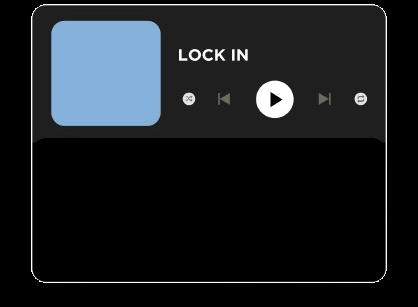
A playlist for when it is 10 pm, and you need to focus and study for the chemistry test first hour next morning. When you need to raise your spirits and force yourself out of the procrastination that
has occurred in your brain ever since your teacher announced the test date. “Misty” by Erroll Garner and “Clair de Lune, L. 32” by Claude Debussy would fit this playlist perfectly.

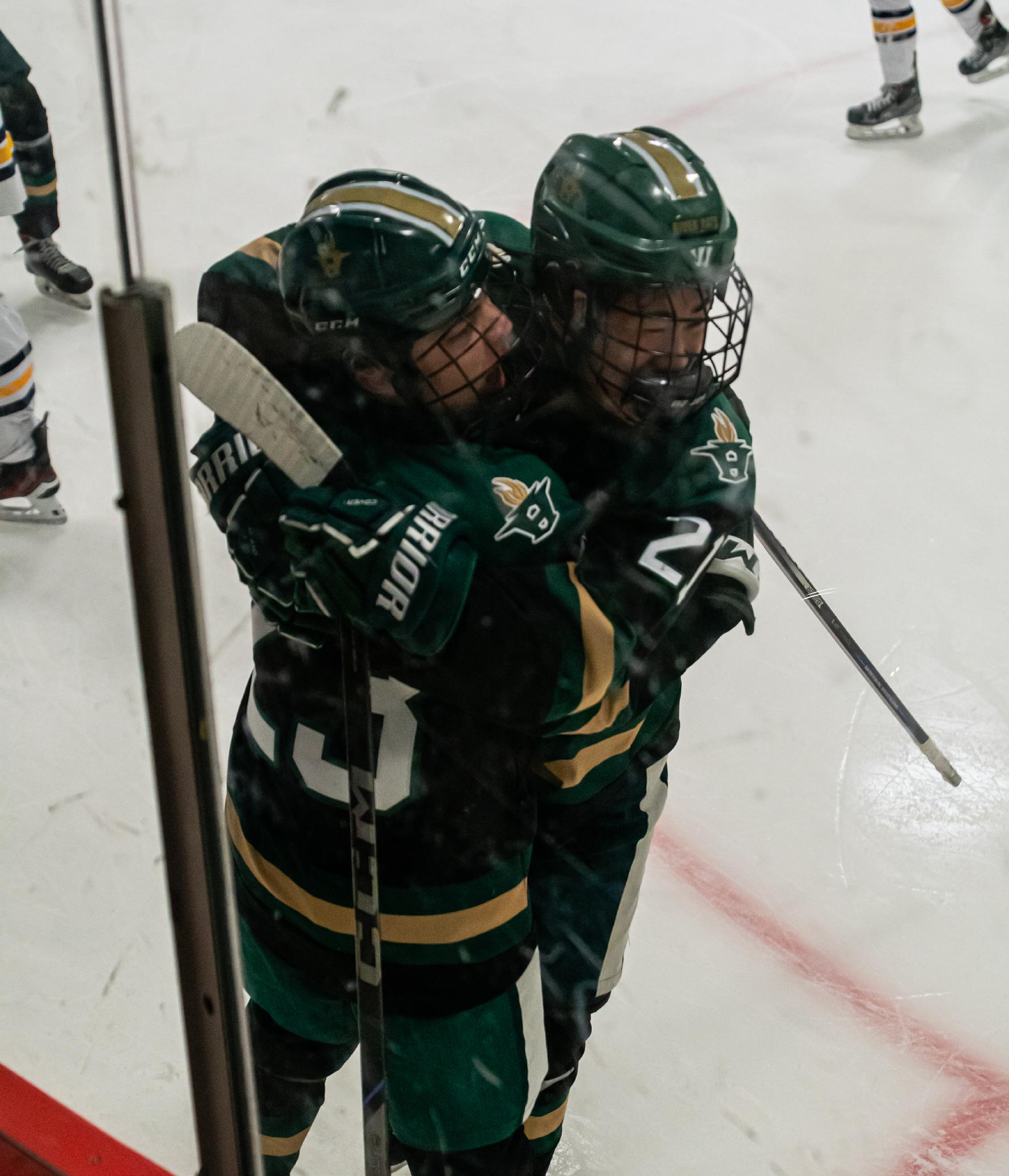
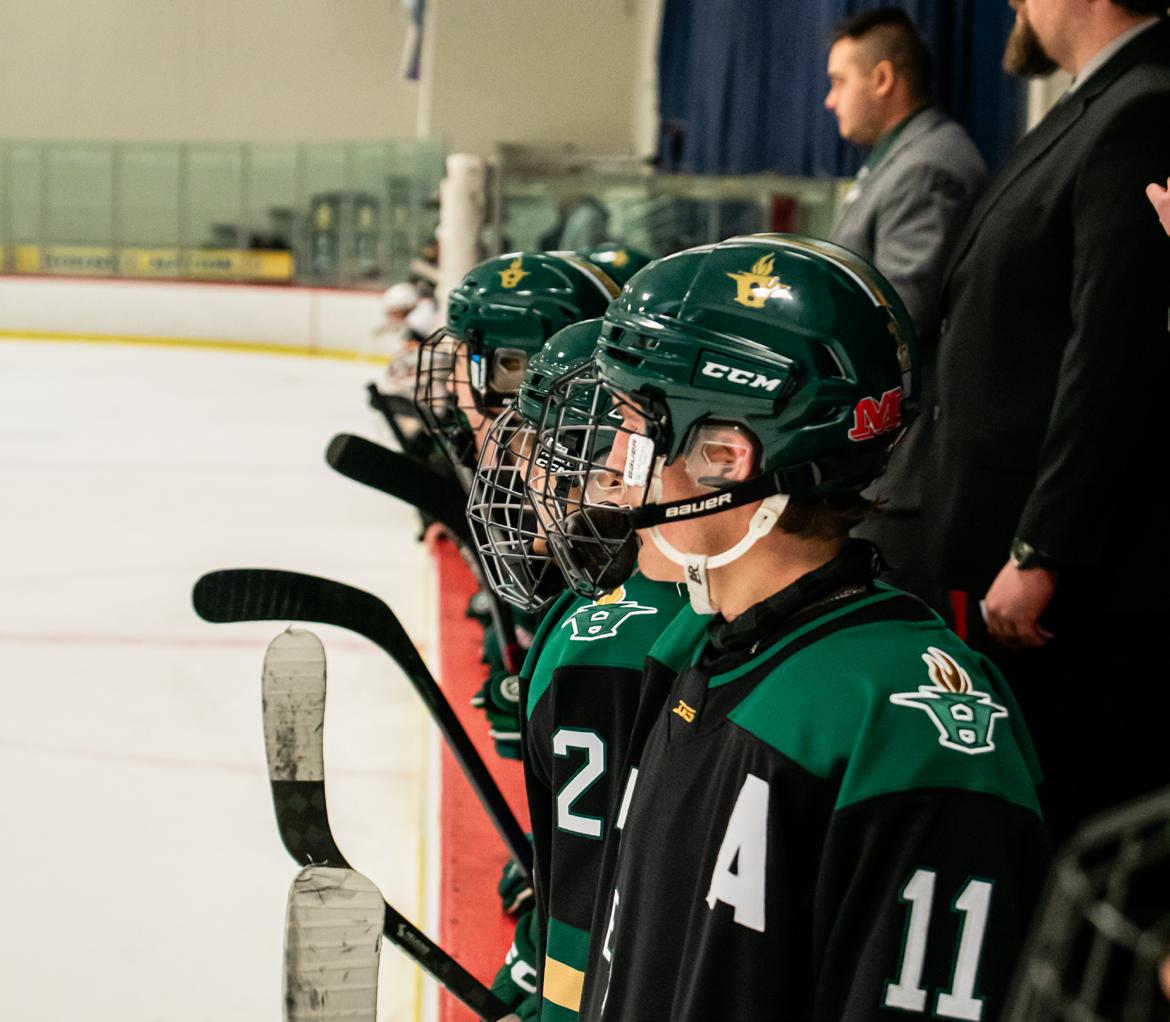


5 1 2 3 4


1. Huron head coach Bill Bonser and his players watch the game from the bench as assistant captain and senior, Brady Brown, prepares to make a line change.
2. Senior defense-man Kyle Fu skates the puck up the ice after curling around the Huron net deep in their own defensive zone. Fu is being chased by two Saline attackers and looks to transition the team into an attacking setup.
3. Senior captain and forward Caleb Patterson handles the puck as he enters the Saline defensive zone across the blue line. The Saline defense is giving Patterson a lot of space due to having to handle the River Rats attack on an odd man rush.
4. Senior forward Brady Brown takes a wrist shot on Huron’s staring goaltender Keagan Dunn in warm-ups before the game.
5. Sophomore defense-man Benny Tarnutzer prepares to dump the puck into the
MAYA FU PRINT EDITOR-IN-CHIEF
It was the Christmas morning of 2012 when senior Caleb Patterson was first drawn to the game of hockey, instantly captivated after trying on the gear that a cousin was gifted.
“I put it on and ever since it’s just been a hit,” said Patterson. “I felt cool wearing the gear, essentially, so it motivated me to keep going.”
Now a captain for Huron’s hockey team, this sport remains an integral part of Patterson’s life. The team has practice Mondays, Tuesdays, and Thursdays at the Ann Arbor Ice Cube. Inconference games usually occur on Wednesdays, while out-of-conference games are reserved for the weekends.
“I manage it all by staying hydrated and having good vibes,” said Patterson.
This positive attitude is what propelled Patterson
through a sprained MCL (medial collateral ligament) in his junior year.
“Luckily nothing was torn, so I didn’t need surgery or anything,” said Patterson.
“But it was still nagging me, and it was hard to trust that the knee was actually going to ever be the same.”
At that point, Patterson was already averaging over a point per game, and wanted to support his team as much as possible.
“[Hockey] is not just a sport,” said Patterson. “It’s also a way to connect with other people on a deeper level. You come out with so many relationships and new friendships from it that just last so much longer than you could ever imagine.”
One of the most prominent examples of this for Patterson was his freshman year season.
“The captain that year was Turner Aldrich,” said Patterson. “Never thought in a million years that I would ever
become such good friends with him, but this dude mentored me. He took me under his wing and taught me everything it took to be a great player.”
These lessons have followed Patterson all the way to his senior year.
“This season is so memorable because throughout the past years of Huron, we’ve always continuously gotten steamrolled by the same SEC opponent,” said Patterson. “But this year, we’re only losing every single game by one goal. Because you’re always thinking about, ‘what else can I do to not be the team that almost did it’, and be the team that actually did it.”
Learning from these losses is another crucial aspect of the game.
I reflect on the loss, and I kind of think about, okay, how could I have approached a certain player on our team a different way so they’d be more receptive to criticism,
because you can’t approach everybody the same way,” said Patterson. “For example, some players, you can be a lot harder on, and you can really get into them about it.”
According to Patterson, the lessons that hockey has taught him reach far beyond the rink.
“One way hockey is applicable to the outside world is through taking accountability for your actions,” said Patterson. “On the ice, if you’re too lazy to take a hit to make a play, or if you’re too lazy to not necessarily put in every single put 100% after every single shift, you’re just taking away from your team. And that’s selfish.”
Recently, in a highly anticipated game against Saline High School, Huron emerged victorious with a score of 7-2, with Patterson scoring two goals and earning two assists.
“We haven’t beat Saline inseason for over 7 years, so it felt incredible to see everything coming together.”

JULES HESKIA GRAPHIC EDITOR
1. Senior Jaydon Keefer and sophomore Nate Sydney contest a shot by the Saline Hornets. The two Huron players are able to get the ball out of the Saline player’s hands. 2. Senior Kaleb Brown, senior Jaydon Keefer, and senior Dominic Krzesowiak (left to right) in the team huddle discussing strategy. The final score of the game was 72-34 in favor of the River Rats. 3. Senior Macari Moore breaking lose for a free dunk. Moore is a key player for Huron as he is their top scorer this season. 4. Junior Kinley Poole with the ball in his hands getting ready to inbound it. 5. Junior Kaiden Morning going for a contested layup in between two Saline players. Morning has stepped us this year, being another key player for the team.
PHOTOS BY BRODY TURNER AND ALEXANDER LOOMIS
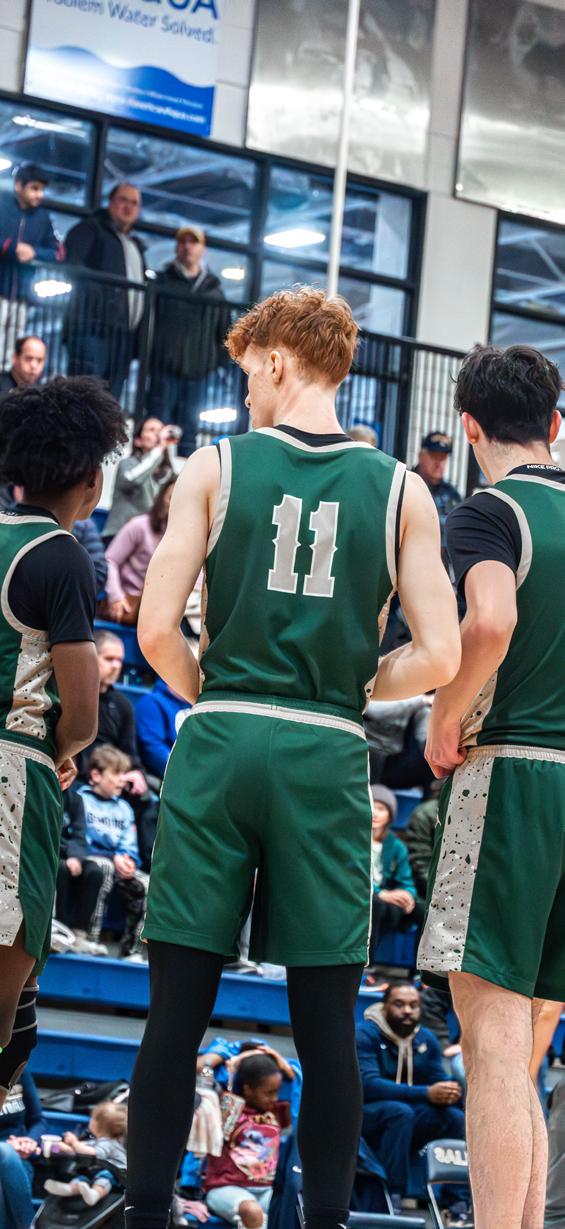
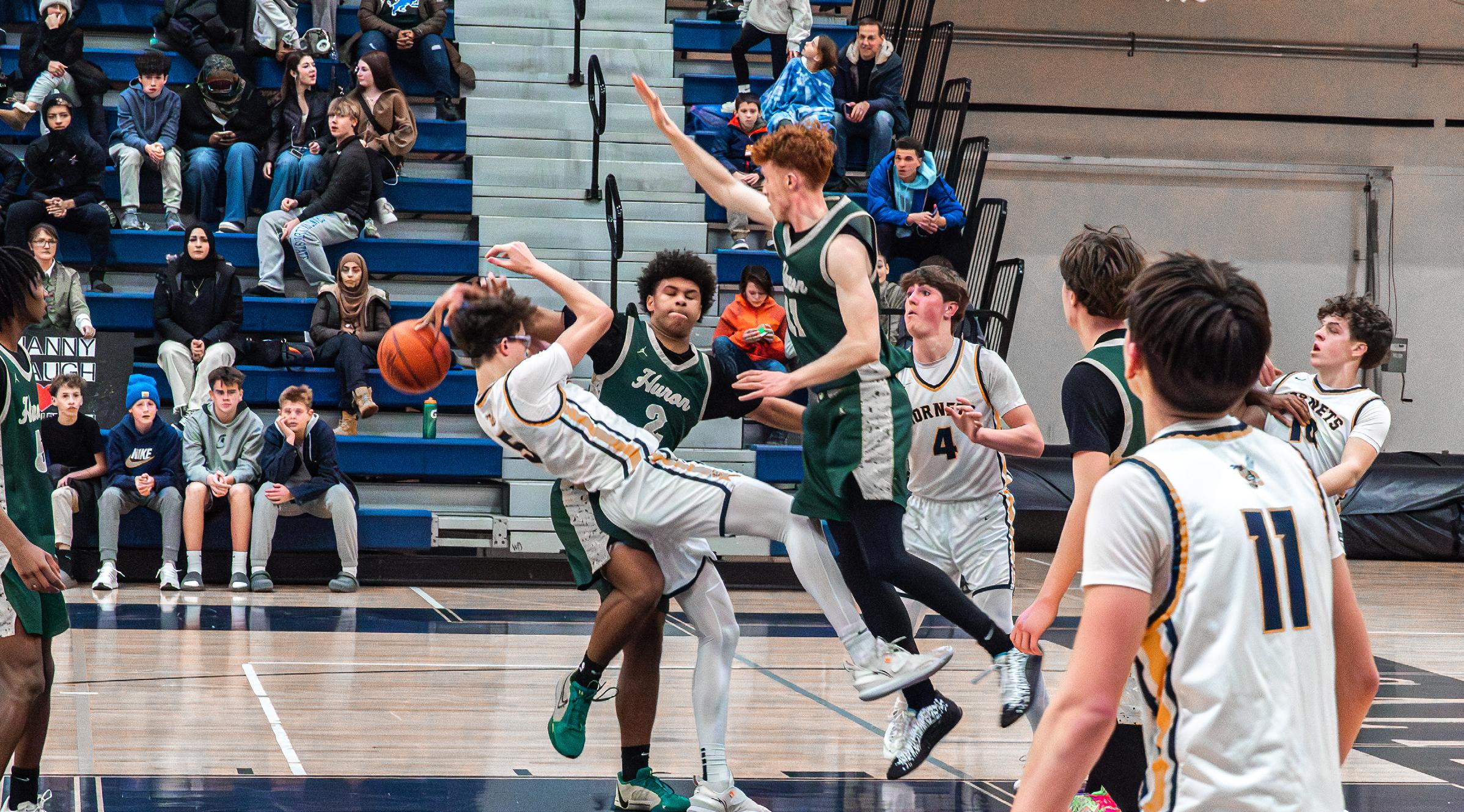



MACKENZEY MILLS STAFF WRITER
Junior Jessa MoseNewman began doing synchronized swimming when she was in 8th grade at Scarlett Middle School and has continued to swim for the Huron team for 3 years. Her favorite thing about synchro is the team bonding events that they have. Even though they have a lot more team members this year, they were all able to form a close bond like she did with her teammates from the year before.
“We all did donuts in the water together and that was a really fun moment,” said Mose-Newman. This was a way for them to get to know each other more before the season started.
“We have a lot of new
teammates this year, but we’ve already gotten pretty close, which is really nice.” MoseNewman said. Just like last year, she became really close to all the new teammates. Her favorite water skill that she can do is the splits because of how much stretching and exercising needed. Jessa MoseNewman says that the most challenging task to do while performing is “stay calm”. She mentions that when they go under the water for figures, they tend to get panicky and start to sink so it’s hard for them to remain calm during that time period. A way she overcomes this is by slowing her figures down a bit. By doing so, it becomes easier to concentrate and helps her feel less afraid when swimming. Many athletes have a certain

food or snack that they eat after games or meets. Post performances Jessa says that she likes to eat Doritos or any kind of chocolate.
Overall, Jessa rates
